There are few words that can explain how hard those days were. However, she still feels proud of being part of a female driver platoon, the only one of its kind formed during the anti-American war.
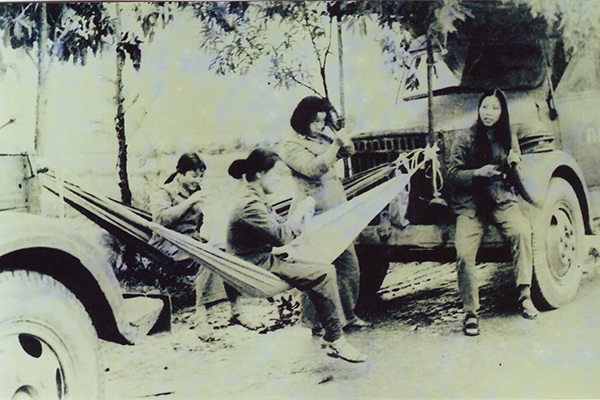 |
| TREACHEROUS WORK: Female drivers take a rest on the Truong Son Mountains route. Photo courtesy of Dung |
Between 1966 and 1967, the US and Sai Gon armed forces increased their attacks against the liberation forces in the South. The US-Sai Gon air forces also tried to disrupt the supplies and reinforcements from the North to the South.
The need for transporting army supplies and personnel for the southern battlefield became more urgent than ever. That’s the reason why the Female Drivers Unit was founded officially under the name of army heroine Nguyen Thi Hanh in 1968.
The female drivers were given the task of transporting goods, soldiers and the wounded. They made history as a heroic platoon. They often suicidally crossed many dangerous places, heavily bombed by US air force, that male drivers were scared of – Dong Loc road junction in Ha Tinh Province, High Point 050, and Heaven’s Gate Pass in Quang Binh Province.
A letter written in blood
Dung was born to a poor family in the northern province of Hung Yen. She was the oldest among five sisters. Her father died when they were young. The family burden was put on her shoulders.
When the Anti-American Youth Volunteer Brigade was established, many young people in the North enthusiastically volunteered to go to war.
In 1967, there was a call for young people to go to the battlefield in the central province of Quang Binh. Dung registered without her mother's knowledge.
A day before enlisting, she was unable to hide the news from her mother and confessed everything. She hadn't seen her mother cry so much since her father passed away. Mother and daughter kept hugging each other and crying because the battlefield was so dangerous. Her mother didn’t want to let the young girl go.
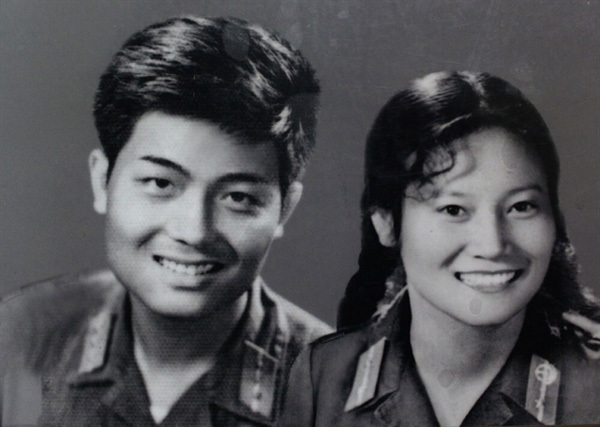 |
| Nguyen Thi Nguyet Anh and her husband Tran Cong Thang. When the country reunited, they met each other again and got married. Photo courtesy of Anh |
Duong Thi The joined the female driver team at the age of 20. She had a boyfriend and wanted to marry him, but she was determined to leave for the sake of the country. She registered to join the army under the name of her older sister. Her parents knew about this decision.
“When I got on the train to the battlefield, I saw my father run after the train. He was angry and threw a rock at the carriage. Seeing that scene, my tears poured out of pity for my father, he did not want me to go into the way of the bombs,” The recalled.
Le Thi Hai Nhi joined the female driver team at the age of 17. She was an orphan so she felt free to join the army. Because she was too young to register, she cut her fingers, using blood to write a letter expressing her strong will to go.
The girls then gathered to join a training course lasting 45 days. They learned to drive and fix the large military trucks. Many of them hadn't even seen a real car because they lived in rural areas. So driving a truck made them scared and excited at the same time.
A gift from President Ho
The Female Drivers Unit was officially founded in 1968 with 40 members. Dung still remembers that she was too small to drive a truck. She weighed just 38kg. She had to put a bag behind her back to reach the wheel.
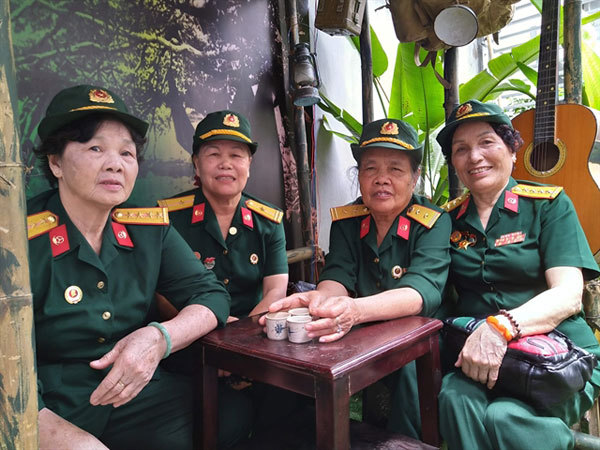 |
| REUNITED: (From left) Drivers Bui Thi Van, Vu Thi Kim Dung, Nguyen Thi Hoa and Nguyen Thi Kim Quy. VNS Photo Minh Thu |
To stay safe and hidden, they drove at night, and hid the trucks in the bushes during the day. Only one light beneath the truck was turned on, just enough to light up about one or two metres ahead. The drivers felt better driving in moonlight. The roads were treacherous, one side a steep cliff, the other an abyss. They could have been bombed by the enemy aircraft at any time.
“We also had to learn how to fix the trucks. Changing tyres was hard because we weren't as strong as the men. Sometimes we felt angry and cried because of helplessness,” said Dung. She broke two front teeth with a wrench while she tried to fix the truck.
The female drivers had to use their mouths to suck the petrol out when they hid the trucks. If not, the trucks may explode if they were hit by a bomb.
“Petrol was very precious. We sucked gasoline out and put it in a barrel, then poured it into the car again from the barrel when we were ready to go. Sometimes we accidentally swallowed the liquid, which is very toxic," Dung said.
The hardships increased when the women got their periods.
“When we got our periods, we went down the stream to wash, then put the cloth and clothes under the bonnet for the heat to dry them so we could use them again,” Dung said.
“We were so young that we were not afraid of death. Like other girls that age, we were scared of ghosts, the dark and wild animals instead.”
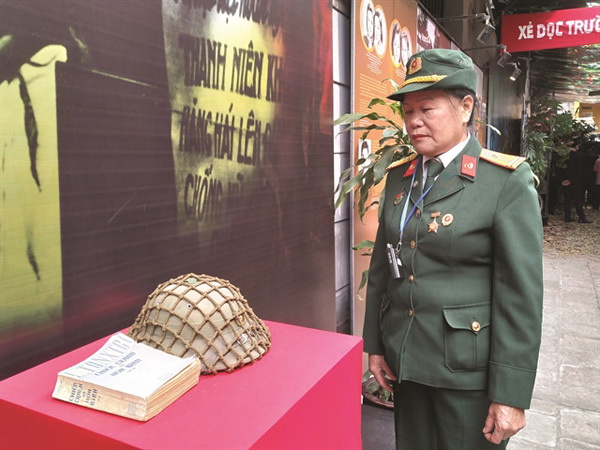 |
| PAINFUL MEMORIES: Vu Thi Kim Dung looks at war memorabilia displayed at the Hoa Lo Prison. She joined the team of female drivers when she was very young. VNS Photo Minh Thu |
Bui Thi Van never forgets the day in 1969 when she thought she would never come home. Her truck was bombed, but luckily, her teammate saved her from the destroyed vehicle.
Another time, she carried many wounded soldiers. They had been bombed again and were seriously injured even more.
On the way, one soldier told Van to sing any song she knew. Van was surprised but tried to sing because music may sooth the pain of the soldiers. She sang many songs, from lullabies, quan họ (love duets) to patriotic songs. When they reached the shelter, one soldier died. His friends told Van that her singing consoled him in his final moments. Van burst into tears. She never forgot that day.
Driver Pham Thi Phan from the northern province of Thai Binh did something extraordinary. She was one of the first two female drivers of the army to surpass High Point 050 in Quang Tri Province which even experienced male drivers were afraid of.
The night was so dark and the vehicle was just inches away from the edge of the cliff, but she remained calm and followed the route. Her bravery was highly appreciated. President Ho Chi Minh gave Phan and her comrades a watch as a gift. Recently, she donated this watch to the Vietnamese Women's Museum.
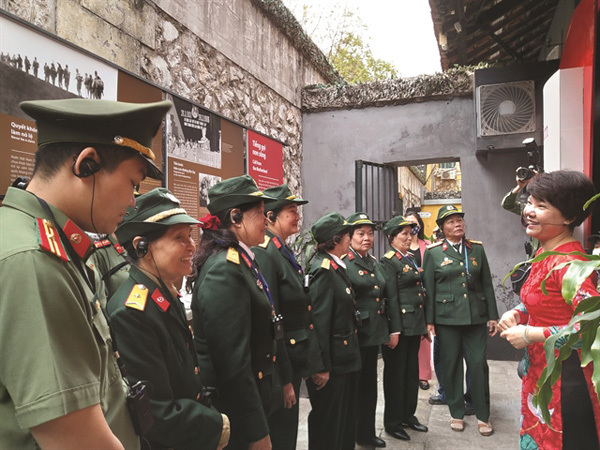 |
| FRIENDS AND COMRADES: Female drivers reunite at Hoa Lo Prison in Hanoi. VNS Photo Minh Thu |
Coming home wounded
The battlefield is arduous and fierce, but it is also the place where many beautiful relationships flourished. The love story of Nguyen Thi Nguyet Anh and her husband Tran Cong Thang is one such case.
They met by chance at a concert in 1966. She was a driver and he an engineer in the army. They fell in love but in 1968, his unit was ordered to go southward and move into Laos.
Although apart from each other, their feelings never faded. He gave her a notebook, in which he had written poems and love letters. Anh said she overcame the troubles during the war thanks to this notebook.
“Every word he wrote helped motivate me to carry on. We waited until the day the war ended,” Anh recalled.
When the country was at peace, the female team drove in the parade ceremony at Ba Dinh Square in Hanoi. When Thang heard there was a female driving team from Truong Son Trail, he ran to the square. They found each other at long last.
In 1977, he moved to the General Department of Logistics and Anh applied to the Ministry of Finance to be a driver. They now live together happily. The little house in Long Bien District, Hanoi, is always full of laughter from their grandchildren.
Returning from the front, some people enjoyed peace and happiness, but others came home with wounds and scars.
When the country was reunified, Dung returned to her homeland. She had lost confidence and turned down many proposals of marriage, because she had passed through the most dangerous roads soaked with poisonous Agent Orange sprayed by the US forces along Truong Son Mountains.
"I saw some of my comrades die of cancer. We all swallowed gas which is very poisonous. I also had lung disease. I am an invalid, so I was not comfortable or confident to marry anyone," Dung said.
A neighbour set her up with Chu Minh Tuan. He was also a soldier, a war correspondent. His wife, a teacher, had died in an accident. At this time, he had three children. He sent Dung a letter with sincere words, expressing how he sympathised with her. The letter touched Dung and they married in 1990.
“I became a wife but can never be a mother, it is a constant regret in my life. Fortunately, my husband's children all love and respect me,” said Dung.
Even so, Dung is delighted with her present happiness. She confided that many other members of the team were even more miserable, some lived in poverty, some never married and lived alone with beautiful memories of their youth.
Despite the fragile border between life and death, all the female drivers survived and came home after the war.
Even 50 years later, they regularly meet up to recall the old stories that stay forever in the minds of the heroic drivers.
“We reunite every year. I am very happy that we all still respect each other. We have passed along the edge of life and death together,” said Dung.
The female drivers sacrificed their youth to the nation. Today, they hope that young people will contribute more to society and respect the value of peace.
VNS
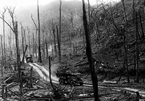
Ho Chí Minh Trail: 60 years and beyond
The song “East of Trường Sơn Calling West” has become a soul-searching tribute to those who trekked through Vietnam’s deepest jungle to unify the country.
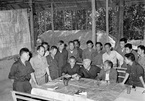
Remembering former President Le Duc Anh
General Le Duc Anh was a leader whose contribution was of immeasurable importance to Viet Nam during both war and peace.